11 Best Herbal Teas For Bloating
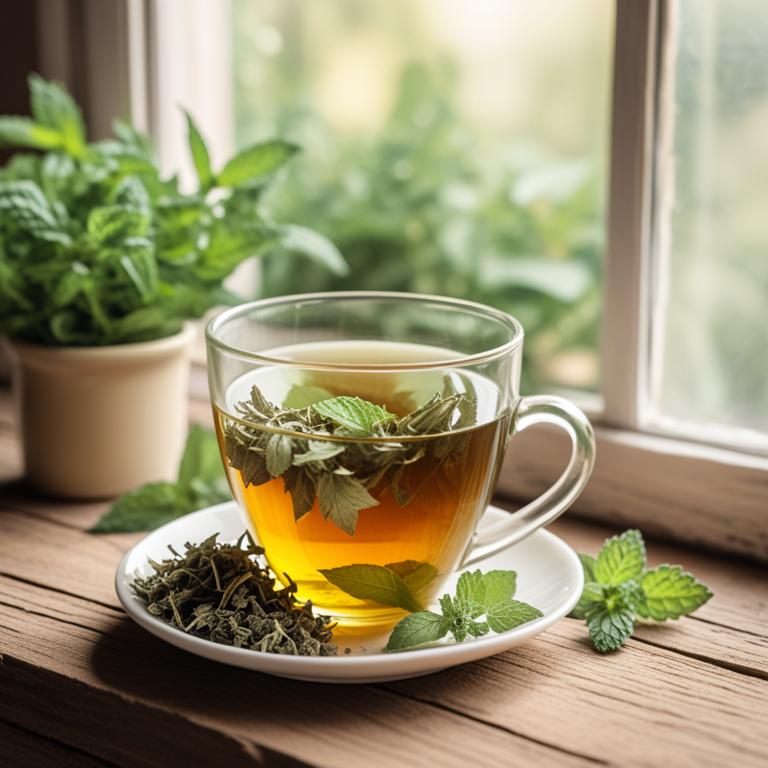
Herbal teas for Bloating are a type of herbal remedy that utilizes the healing properties of various plants to alleviate the discomfort and swelling associated with bloating.
This natural remedy works by soothing the digestive system, reducing inflammation, and promoting the proper functioning of the body's metabolic processes.
Examples of herbal teas that can help treat bloating include peppermint tea, which relaxes the muscles in the digestive tract and reduces nausea; ginger tea, which reduces inflammation and stimulates digestion; fennel tea, which eases gas and cramps; chamomile tea, which calms the nervous system and promotes relaxation; dandelion tea, which supports liver function and aids in the elimination of toxins; and licorice root tea, which soothes the stomach and reduces inflammation.
By incorporating these herbal teas into one's diet, individuals can find relief from the discomfort of bloating and maintain a healthy digestive system.
Related Study
According to "Physiological research", teas for bloating may be effective due to the presence of catechins and theaflavins in tea, which can help reduce fat metabolism, appetite, and food absorption in the gastrointestinal system.
Below there's a list of the 11 best herbal teas for bloating.
Table of Contents
Also, you may be interested in...
Today Free Bonus!
The Ultimate Herb Drying Checklist
(For Long-Lasting Powerful Medicinal Effect)
How to easily dry herbs that don't mold and that keep their strong medicinal power for more than 1 year.
1. Zingiber officinale teas

Zingiber officinale teas, commonly known as ginger tea, have been used to treat the bloating ailment due to its anti-inflammatory properties, which help to alleviate symptoms such as discomfort and swelling.
The bioactive constituents of ginger tea, including gingerols and shogaols, have been shown to stimulate digestion and relieve nausea, further contributing to its effectiveness in treating bloating.
The benefits of ginger tea in treating bloating include improved digestion, reduced inflammation, and enhanced gut health, making it a popular natural remedy for this condition.
Regular consumption of ginger tea has been found to provide long-term relief from bloating, as well as other gastrointestinal issues, making it a valuable addition to a healthy lifestyle.
Related Study
According to "Pakistan journal of pharmaceutical sciences", Zingiber officinale teas, which contain significant antioxidant activity and high levels of total flavonoid, phenolic acids, and polyphenols, may be beneficial in reducing bloating due to their ability to neutralize free radicals and promote digestive health.
Recipe:
- Gather 1 teaspoon of fresh ginger root or 1/2 teaspoon of dried ginger root.
- Boil 1 cup of water in a pot and let it cool for a minute.
- Add the ginger root to the water and let it steep for 5-7 minutes.
- Strain the tea into a cup and add honey or lemon to taste.
- Drink 1 cup of the tea 30 minutes before meals to help with bloating.
Zingiber officinale teas can help alleviate bloating symptoms, but may also cause side effects such as stomach upset, nausea, and diarrhea in some individuals due to its high ginger content.
Precautions should be taken to avoid consuming excessive amounts, as this may exacerbate digestive issues, and pregnant women and breastfeeding mothers should be cautious when using Zingiber officinale teas to treat bloating.
Zingiber Officinale Tea on Amazon
FGO Organic Ginger Tea, 100 Count, Eco-Conscious Tea Bags, Caffeine Free, Packaging May Vary (Pack of 1)
Disclaimer: We earn a commission if you click this link and make a purchase at no additional cost to you.
2. Glycyrrhiza glabra teas

Glycyrrhiza glabra teas, also known as licorice root tea, have been traditionally used to treat bloating due to its anti-inflammatory and carminative properties.
The herbal preparation helps to alleviate bloating by reducing inflammation in the digestive tract and promoting the relaxation of muscles in the digestive system, thereby allowing for smoother digestion and reduced discomfort.
The bioactive constituents of Glycyrrhiza glabra tea, including glycyrrhizin and flavonoids, possess anti-inflammatory and antioxidant properties that contribute to its therapeutic effects in treating bloating.
The benefits of consuming Glycyrrhiza glabra teas to treat bloating include reduced abdominal discomfort, improved digestion, and a decrease in overall symptoms associated with this ailment.
Recipe:
- Gather 1 teaspoon of dried Glycyrrhiza glabra root and 1 cup of water.
- Boil the water in a pot and let it cool for 1 minute.
- Add the dried Glycyrrhiza glabra root to the cooled water.
- Steep the mixture for 5-7 minutes, then strain the liquid using a tea strainer.
- Drink the tea 1-2 times a day, as needed, to help reduce bloating.
Glycyrrhiza glabra teas can be used to treat bloating, but long-term consumption may lead to potential side effects such as water retention, high blood pressure, and an increased risk of potassium deficiency.
Precautions should be taken when using these teas, including limiting consumption to short periods, monitoring blood pressure, and staying hydrated to avoid exacerbating symptoms.
Glycyrrhiza Glabra Tea on Amazon
Pukka Herbal Teas Licorice and Cinnamon - 20 Bags, 20 Count
Disclaimer: We earn a commission if you click this link and make a purchase at no additional cost to you.
3. Foeniculum vulgare teas
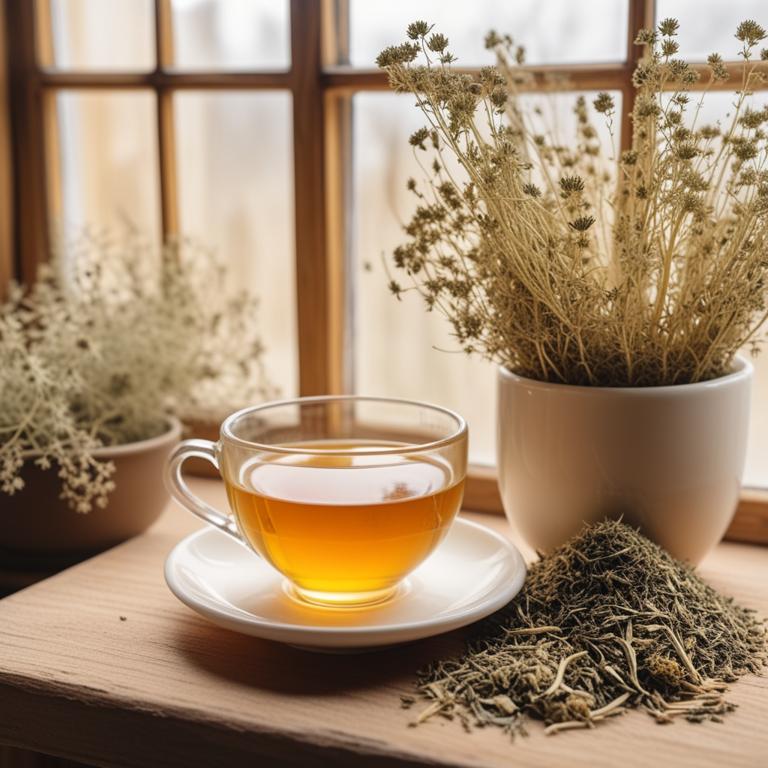
Foeniculum vulgare teas, also known as fennel tea, have been used for centuries to alleviate bloating and gas-related discomfort due to its carminative properties, which help to release trapped gas from the digestive system.
The bioactive constituents, including anethole, limonene, and fenchone, in fennel tea work together to relax the muscles in the digestive tract and reduce inflammation, thereby providing relief from bloating.
The benefits of fennel tea in treating bloating include its ability to stimulate digestion, reduce spasms, and promote the elimination of toxins from the body, leading to a feeling of comfort and well-being.
Regular consumption of fennel tea can also help to regulate bowel movements, alleviate symptoms of IBS, and support overall digestive health.
Related Study
According to the provided scientific study, Foeniculum vulgare teas may help alleviate bloating due to its antispasmodic properties, which can relieve contraction and cramping of smooth muscles in the gastrointestinal system.
Recipe:
- Gather 1 cup of water, 1 tablespoon of Foeniculum vulgare seeds, and a heat-resistant cup.
- Bring the water to a boil in a pot.
- Add the Foeniculum vulgare seeds to the boiling water and let it simmer for 5-7 minutes.
- Strain the mixture into the heat-resistant cup and let it cool down.
- Drink the tea slowly to help with bloating symptoms.
Foeniculum vulgare teas can be an effective remedy for treating bloating, but possible side effects may include digestive discomfort, such as nausea and stomach cramps, as well as allergic reactions like skin irritation or itching.
To minimize potential risks, it is recommended to start with small amounts and gradually increase the dosage, avoid mixing with other herbal preparations, and be cautious when consuming if you have a history of sensitive stomach or allergies.
Foeniculum Vulgare Tea on Amazon
Fennel Tea - 100% Organic and Alkaline - 15 Unbleached/Chemical-Free Fennel Tea Bags - Caffeine-Free, No GMO
Disclaimer: We earn a commission if you click this link and make a purchase at no additional cost to you.
4. Peumus boldus teas
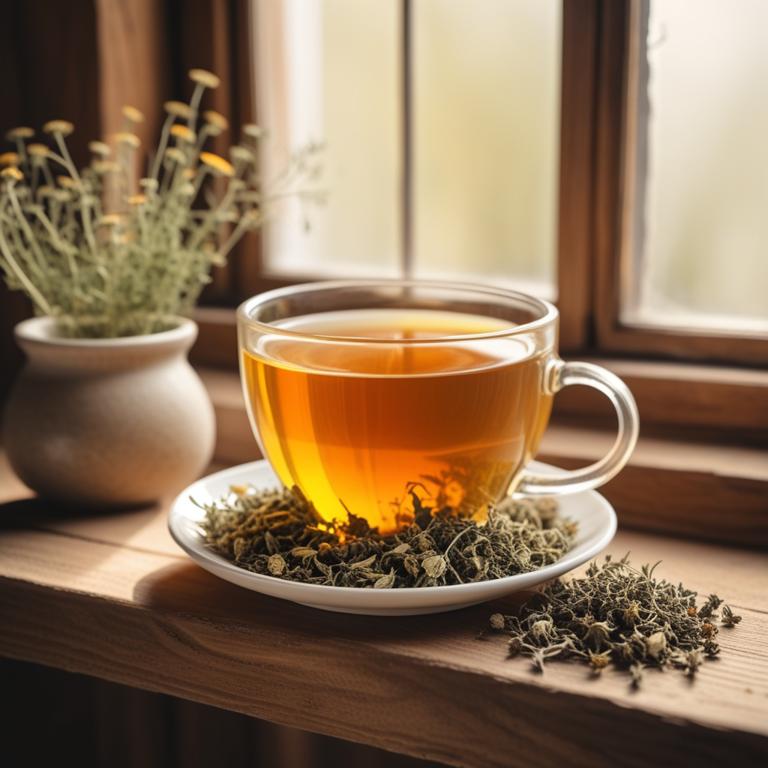
Peumus boldus teas, also known as boldo tea, have been traditionally used to treat bloating and alleviate digestive discomfort.
The properties of this herbal preparation that help to treat this ailment include its carminative and anti-inflammatory properties, which help to ease digestion and reduce inflammation in the abdominal region.
The bioactive constituents of boldo tea, such as flavonoids and terpenoids, are responsible for its therapeutic effects, including its ability to relax the smooth muscles in the digestive tract and reduce spasms.
The benefits of using boldo tea to treat bloating include its natural and non-invasive approach, which can help to promote overall digestive health and reduce symptoms of bloating and discomfort.
Recipe:
- Gather 1 teaspoon of dried Peumus boldus leaves and 1 cup of water.
- Heat the water in a pot until it reaches boiling point.
- Remove the pot from heat and add the dried Peumus boldus leaves.
- Let the leaves steep in the water for 5-7 minutes.
- Strain the tea and drink 1-2 cups as needed to help with bloating.
Peumus boldus teas can be effective in treating bloating, but potential side effects may include stomach upset, nausea, and diarrhea in some individuals.
Precautions should be taken when using this herbal preparation, such as starting with small doses and monitoring body reactions, and avoiding it if you have sensitive stomach or allergies to certain plants.
5. Silybum marianum teas
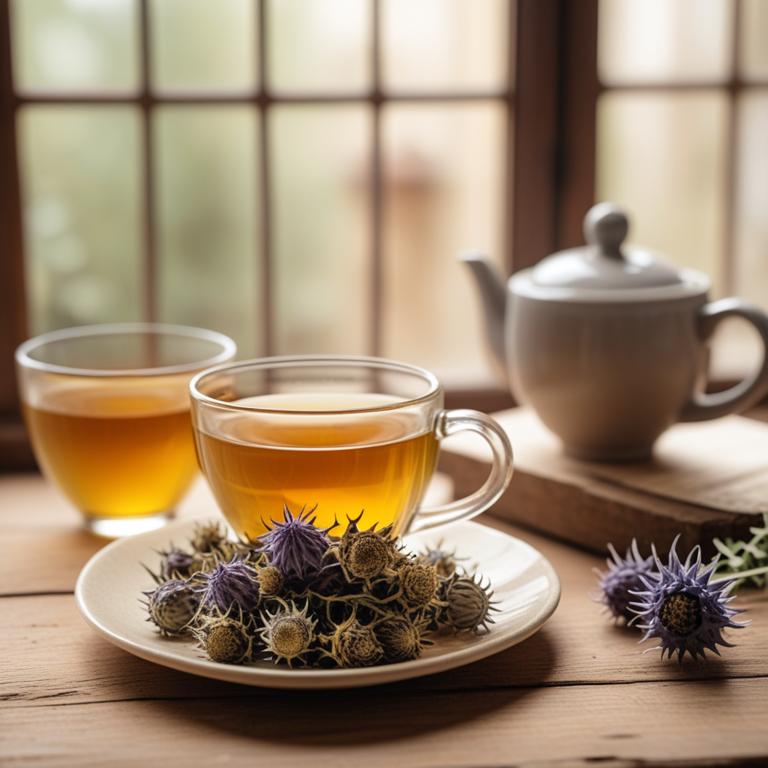
Silybum marianum teas, derived from the milk thistle plant, have been traditionally used to treat bloating and other digestive issues due to their anti-inflammatory and antioxidant properties.
The bioactive constituents of Silybum marianum, including silymarin and flavonoids, help to reduce inflammation and improve the health of the gut, ultimately alleviating bloating and discomfort.
By increasing the production of bile and improving the balance of gut bacteria, Silybum marianum teas help to regulate digestion and prevent bloating.
The benefits of using Silybum marianum teas to treat bloating include reduced inflammation, improved gut health, and enhanced overall digestive well-being.
Recipe:
- Gather Silybum marianum flowers and leaves (about 1 cup) and clean them.
- Put 1 cup of water in a pot and bring it to a boil.
- Add 1 tablespoon of the cleaned flowers and leaves to the boiling water.
- Reduce heat, cover the pot, and let it simmer for 10-15 minutes.
- Strain the liquid and drink 1/2 cup of the tea, 2-3 times a day to help with bloating.
Silybum marianum teas can be used to treat bloating ailments, but it may cause side effects such as stomach upset, diarrhea, and allergic reactions in some individuals.
Precautions should be taken when using this herbal preparation, as it can interact with certain medications and exacerbate conditions such as kidney disease, so it's essential to start with small doses and monitor your body's response carefully.
Silybum Marianum Tea on Amazon
Celebration Herbals Organic Milk Thistle Seed Herbal Tea -- 24 Tea Bags, NET WT.60, 2.11 OZ
Disclaimer: We earn a commission if you click this link and make a purchase at no additional cost to you.
6. Cuminum cyminum teas
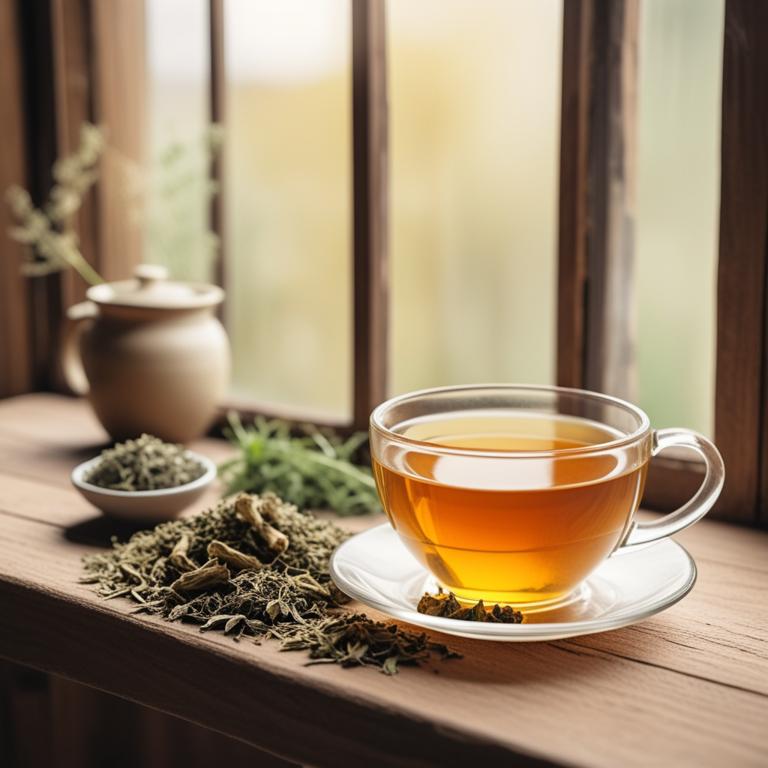
Cuminum cyminum teas, also known as cumin tea, have been traditionally used to treat bloating ailments due to their carminative and anti-inflammatory properties.
The bioactive constituents, such as cumin oil and limonene, help to ease digestion and reduce inflammation in the gut, making it easier to pass gas and alleviate bloating symptoms.
The active compounds in cumin tea, including apigenin and luteolin, also possess antimicrobial properties that help to regulate gut bacteria and prevent the growth of pathogens that can contribute to bloating.
The benefits of using cumin tea to treat bloating include improved digestion, reduced inflammation, and a decrease in symptoms such as abdominal cramps and discomfort.
Recipe:
- Boil 1 cup of water in a kettle or pot.
- Take 1 teaspoon of Cuminum cyminum seeds and add them to a tea infuser.
- Pour the boiling water over the Cuminum cyminum seeds in the tea infuser.
- Steep the mixture for 5-7 minutes, then remove the tea infuser.
- Drink the tea, straining it if needed, and add honey or lemon to taste.
Cuminum cyminum teas can help alleviate bloating symptoms due to its carminative properties, but possible side effects include stomach upset, diarrhea, and allergic reactions in some individuals.
To use Cuminum cyminum teas safely, take small doses and start with a low concentration, gradually increasing it as needed, and avoid consuming it before surgery or with other medications that may interact with its active compounds.
7. Lavandula angustifolia teas

Lavandula angustifolia teas have been traditionally used to treat bloating, a common digestive issue characterized by uncomfortable abdominal swelling and discomfort.
The anti-inflammatory and antispasmodic properties of this herbal preparation help to ease digestive discomfort, reduce cramping, and promote relaxation, making it an effective remedy for bloating.
Lavandula angustifolia teas contain bioactive constituents such as linalool and linalyl acetate, which have been shown to possess anti-inflammatory and antioxidant properties that help to reduce inflammation and alleviate digestive symptoms associated with bloating.
Regular consumption of Lavandula angustifolia teas may provide relief from bloating, improve overall digestive health, and promote a sense of calm and well-being.
Related Study
According to "Oxidative medicine and cellular longevity", Lavandula angustifolia teas may provide relief from bloating due to the presence of biologically active compounds that possess significant spasmolytic effects, helping to ease gastrointestinal discomfort.
Recipe:
- Gather 1 cup of fresh Lavandula angustifolia flowers or 2 teaspoons of dried flowers.
- Heat 1 cup of boiling water.
- Add the Lavandula angustifolia flowers to the boiling water and let it steep for 5-7 minutes.
- Strain the tea into a cup using a fine-mesh sieve or cheesecloth and discard the flowers.
- Drink 1 cup of the tea, 2-3 times a day, to help reduce bloating.
Lavandula angustifolia teas can be used to treat bloating, but possible side effects may include dizziness, nausea, and stomach upset due to the relaxation of the digestive system and potential interactions with other medications.
To use this herbal preparation safely, it is essential to start with a small dose, gradually increase the amount, and avoid consuming it before bedtime or with other sedatives to minimize the risk of adverse reactions.
Lavandula Angustifolia Tea on Amazon
Tiesta Tea - Lavender Chamomile Herbal Tea | Loose Leaf | Calming Blend with Chamomile and Lavender | Caffeine-Free Herbal | Great for Hot or Iced Brews | Resealable Bulk Pouch, 200 Cups | 8 Ounce
Disclaimer: We earn a commission if you click this link and make a purchase at no additional cost to you.
8. Curcuma longa teas
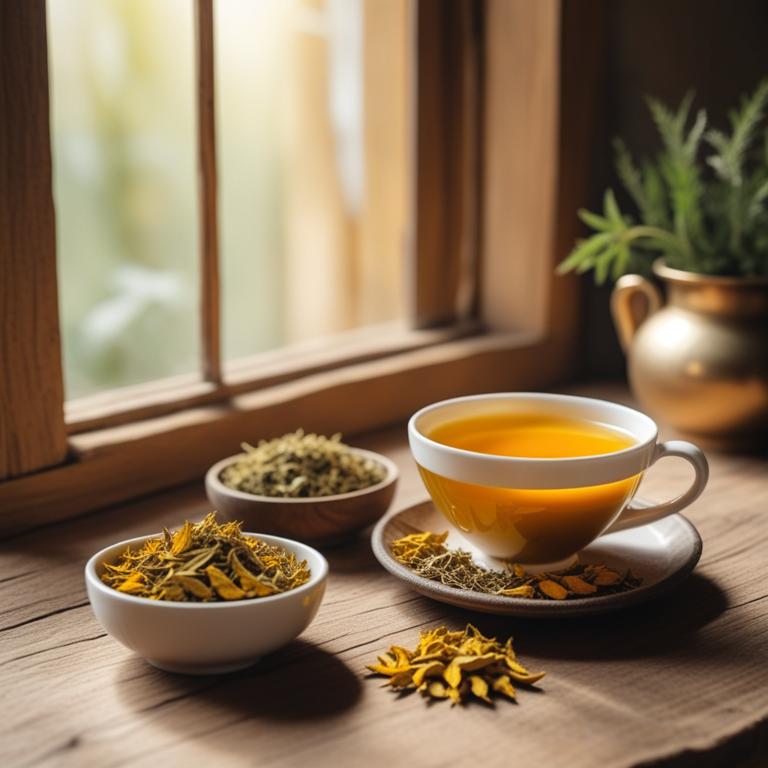
Curcuma longa teas, derived from the rhizomes of the Curcuma longa plant, have been traditionally used to treat bloating and other digestive issues.
The bioactive constituents of Curcuma longa teas, including curcuminoids, turmerones, and sesquiterpenes, possess anti-inflammatory and antioxidant properties that help to alleviate bloating by reducing inflammation and improving digestion.
These bioactive constituents also help to regulate gut bacteria and enhance gut motility, thereby reducing the discomfort and pain associated with bloating.
The benefits of using Curcuma longa teas to treat bloating include improved digestion, reduced inflammation, and enhanced overall gut health, making it a natural and effective remedy for this common ailment.
Related Study
According to the provided study, Curcuma longa teas for bloating may be beneficial due to the presence of curcumin, a phytochemical compound that has potential in alleviating digestive discomfort and pain.
Recipe:
- Get 1 teaspoon of dried Curcuma longa root.
- Boil 1 cup of water in a pot.
- Add the Curcuma longa root to the boiling water.
- Reduce heat and let it simmer for 5-7 minutes.
- Strain the tea and drink it warm, 2-3 times a day.
Curcuma longa teas can be effective in treating bloating, but possible side effects may include stomach upset, nausea, and diarrhea due to its potency and potential interaction with medications.
To use Curcuma longa teas safely, it is recommended to start with a low dose, avoid consuming it on an empty stomach, and be cautious when combining it with other medications or herbal supplements, as this may exacerbate the side effects.
Curcuma Longa Tea on Amazon
Pure Ceylon Turmeric Brew - 100% Organic Ceylon Turmeric Tea Bags (40 Sachets - pack of 2 – 20 COUNT PER BOX)
Disclaimer: We earn a commission if you click this link and make a purchase at no additional cost to you.
9. Rosmarinus officinalis teas

Rosmarinus officinalis teas, also known as rosemary tea, have been traditionally used to treat bloating and gas issues due to their carminative and anti-inflammatory properties.
The herbal preparation helps to treat bloating by reducing inflammation in the digestive tract, relaxing muscles, and improving digestion, thus alleviating discomfort and pain.
Rosemary tea contains bioactive constituents such as rosmarinic acid, carnosic acid, and camphor, which contribute to its anti-inflammatory and antimicrobial effects, further aiding in the treatment of bloating.
The benefits of using rosemary tea to treat bloating include reduced symptoms, improved digestion, and a decrease in the production of gas, providing relief from discomfort and promoting a healthier digestive system.
Related Study
According to the information about herbal remedies for gastrointestinal conditions, Rosmarinus officinalis teas may have potential in alleviating bloating by containing phytochemicals such as flavonoids and phenolics.
Recipe:
- Gather 1 cup of boiling water and 1-2 teaspoons of dried Rosmarinus officinalis leaves.
- Measure 1-2 teaspoons of dried Rosmarinus officinalis leaves and place them in a tea infuser or a small muslin bag.
- Pour the boiling water over the Rosmarinus officinalis leaves in the tea infuser or muslin bag.
- Let the tea steep for 5-7 minutes, then remove the leaves or muslin bag.
- Drink 1 cup of the Rosmarinus officinalis tea, 1-2 times a day, to help with bloating.
Rosmarinus officinalis teas can be an effective remedy for bloating, but it may cause side effects such as stomach upset, nausea, or allergic reactions in some individuals due to its high concentration of volatile oils.
To safely use Rosmarinus officinalis teas for bloating, it is recommended to start with a low dose, drink it in moderation, and avoid consuming it before bedtime or when planning to engage in strenuous activities.
Rosmarinus Officinalis Tea on Amazon
Palm Beach Medicinal Herbs - Rosemary Tea - Pure Herbal Tea Series, 30ct
Disclaimer: We earn a commission if you click this link and make a purchase at no additional cost to you.
10. Mentha x piperita teas
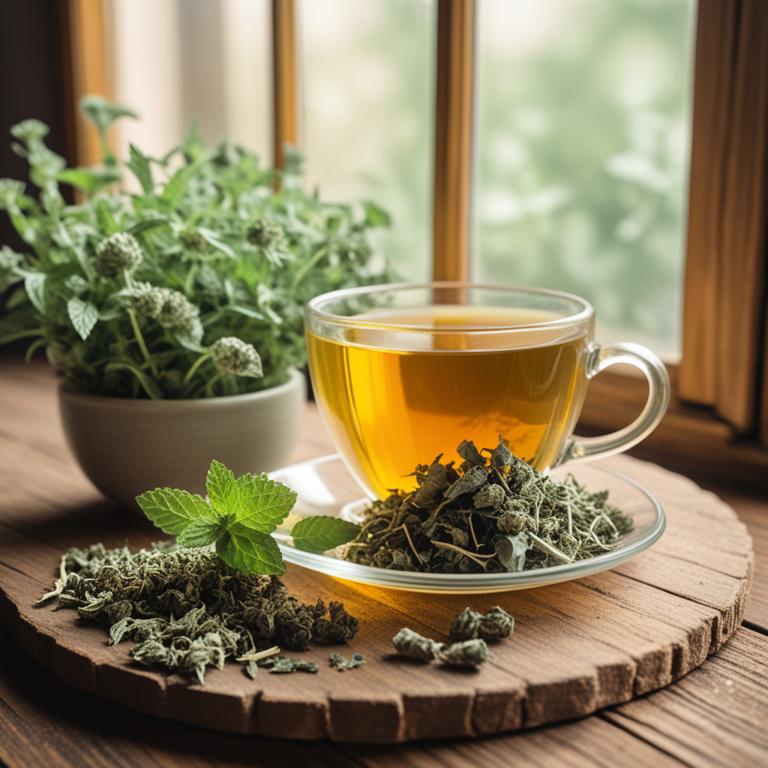
Mentha x piperita teas, also known as peppermint tea, have been traditionally used to treat bloating by providing relief from discomfort and reducing gas.
The properties of peppermint tea, including its anti-inflammatory and carminative effects, help to soothe the digestive system and ease bloating symptoms.
The bioactive constituents of peppermint tea, such as menthol and menthone, work to relax the muscles in the digestive tract and improve digestion, thereby reducing bloating.
The benefits of peppermint tea in treating bloating include its ability to improve digestion, reduce inflammation, and provide quick relief from symptoms, making it a popular natural remedy for this common ailment.
Related Study
According to "Current pharmaceutical biotechnology", Mentha x piperita teas for bloating may be beneficial due to its anti-inflammatory and antioxidant potentials, which may help in the management of visceral hypersensitivity.
Recipe:
- Gather 1 cup of fresh mint leaves (Mentha x piperita) or 1 teaspoon of dried mint leaves.
- Boil 1 cup of water and let it cool for 1-2 minutes.
- Add 1/2 cup of fresh mint leaves (or 1 teaspoon of dried mint) to the cooled water.
- Steep for 5-7 minutes, then strain the liquid into a cup.
- Drink the tea warm or at room temperature, ideally 1-2 times a day.
Mentha x piperita teas can be beneficial in alleviating bloating symptoms, but consuming them excessively may lead to side effects such as stomach upset, nausea, and dizziness due to the high concentration of menthol and other volatile oils.
To safely use Mentha x piperita teas, it is recommended to start with small amounts, brew the tea for a shorter duration, and avoid consuming it on an empty stomach to minimize potential side effects like stomach discomfort and allergic reactions.
11. Pimpinella anisum teas

Pimpinella anisum teas, also known as anise tea, have been traditionally used to treat bloating and other digestive issues due to their carminative and antispasmodic properties.
The bioactive constituents of anise tea, including anethole, limonene, and borneol, help to reduce inflammation and relax the muscles in the digestive tract, thereby alleviating bloating and discomfort.
Anise tea also has a mild antacid effect, which helps to neutralize stomach acid and soothe the digestive system.
The benefits of using anise tea to treat bloating include reduced symptoms, improved digestion, and a sense of overall well-being.
Related Study
According to the provided scientific study, Pimpinella anisum teas for bloating may be beneficial in functional dyspepsia due to its potential to improve symptoms and modulate GI motility.
Recipe:
- Gather 1 cup of fresh or dried Pimpinella anisum leaves.
- Measure 1 tablespoon of Pimpinella anisum leaves and place it in a tea infuser or a heat-resistant cup.
- Boil 1 cup of water in a kettle or on the stovetop. Let it cool for 1-2 minutes.
- Pour the boiled water over the Pimpinella anisum leaves in the tea infuser or cup. Let it steep for 5-7 minutes.
- Strain the tea and discard the leaves. Drink the tea hot or cold, 1-2 times a day to help with bloating.
Pimpinella anisum teas can help alleviate bloating symptoms, but some possible side effects may include nausea, dizziness, and allergic reactions in rare cases.
When using Pimpinella anisum teas to treat bloating, it is recommended to start with small doses and gradually increase as needed, to avoid over-stimulation and potential interactions with other medications, and to monitor the body's response closely.